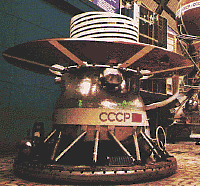
Venera 13 and 14 were identical spacecraft built to take advantage of the 1981 Venus launch opportunity and launched 5 days apart. The Venera 14 mission consisted of a bus (81-110A) and an attached descent craft (81-110D). The Venera 14 descent craft/lander was a hermetically sealed pressure vessel, which contained most of the instrumentation and electronics, mounted on a ring-shaped landing platform and topped by an antenna. The design was similar to the earlier Venera 9-12 landers. It carried instruments to take chemical and isotopic measurements, monitor the spectrum of scattered sunlight, and record electric discharges during its descent phase through the Venusian atmosphere. The spacecraft utilized a camera system, an X-ray fluorescence spectrometer, a screw drill and surface sampler, a dynamic penetrometer, and a seismometer to conduct investigations on the surface.
After launch and a four month cruise to Venus, the descent vehicle separated from the bus and plunged into the Venus atmosphere on 5 March 1982. After entering the atmosphere a parachute was deployed. At an altitude of about 50 km the parachute was released and simple airbraking was used the rest of the way to the surface. Venera 14 landed about 950 km southwest of Venera 13 near the eastern flank of Phoebe Regio at 13 deg 15 min S by 310 E on a basaltic plain. After landing an imaging panorama was started and a mechanical drilling arm reached to the surface and obtained a sample, which was deposited in a hermetically sealed chamber, maintained at 30 degrees C and a pressure of about .05 atmospheres. The composition of the sample was determined by the X-ray flourescence spectrometer, showing it to be similar to oceanic tholeiitic basalts. The lander survived for 57 minutes (the planned design life was 32 minutes) in an environment with a temperature of 465 degrees C and a pressure of 94 Earth atmospheres. The descent vehicle transmitted data to the bus, which acted as a data relay as it flew by Venus.